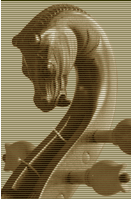 |
 |
 |
|||||||
From what I understood from the articles mentioned above, the proposed procedure allowed me to obtain archings with steep transversal ascent, but I could never obtain archings with more gradual curves toward the upper and lower bout.The center bout is a particularly difficult area, since the arching rises rapidly in its very middle, but takes on a more gradual ascent right before and after it. As a matter of fact the templates for the bellies of a few originals, including the Jaye viol and two by Colichon which I personally traced, plus several more in my possession, show sort of an gintermediateh arching, which can be obtained only with some difficulties following the method I illustrated above, therefore I thought I could try and tackle experimentally one of the possible solutions of this problem.
At last I was able to perfect a sequence of procedures, which led to the desired results, and I'm going to describe it to you.
(1) Dietrich M. Kessler
Viol construction in 17th-century England: an alternative way of making fronts.
Early Music July 1982
(2) Tilman Muthesius
Die gebogene Gambendecke: Eine andere historische Deckenkonstruktion im 16. und 17 Jahrhundert
Bericht uber das 11. Symposium
zu Fragen des Musikinstrumentenbaus
Michaelstein, 9.-10.Nov.1990
Institut fur Auffuhrungspraxis Michaelstein, 1994


| << Prev. | Next >> |